Lucca is positioned close to Pisa and had its chief rivalry with this town rather than Florence. Lucca remained independent for most of its history after being a Roman Colony, occasionally ruled by Pisa several times in the 1300s and free for over 400 years until ultimately being conquered by Napoleon in 1805 and part of the Grand Duchy of Tuscany before becoming part of a unified Italy in 1860.
With my wife’s family based in Prato, less than an hour away by car, I have visited Lucca several times for enjoyable day trips to take in the sights, visit the shops and restaurants and soak in the relaxed, picturesque surroundings.
Lucca’s encircling defensive walls from the 16th and 17th centuries are now one of its most endearing features and offer a lovely way to get some exercise and have a different perspective on the city and the surrounding countryside. The town has Roman roots, and this is exhibited by the circular shaped Piazza dell’Anfiteatro where the old Roman Amphitheater stood, and the beautiful San Michele in Foro church stands in the piazza which was the former site of the Roman forum.
The so-called town of a hundred churches has several can’t miss religious destinations including the Duomo or San Martino Cathedral, San Michele in Foro, and the gorgeous mosaics of the Basilica of San Frediano. The facades of these churches are among the most impressive you’ll find in all of Italy.
Enjoy the views by climbing one of Lucca’s medieval towers, either the Guinigi Tower with its trees growing on the rooftop terrace, or the Torre dell Ore clocktower, or both if your legs are up to the climbing of many stairs!
Lucca is proud of its native son Giacomo Puccini, and his birthplace and statue are one of the most interesting stops within the city. On many evenings you’ll find concerts available in local churches featuring some of his most famous opera music. Other museums of note include two national museums, the Villa Guinigi with its art and archeological collection and the Villa Mansi house museum with its rich collection of artwork, furnishings, and tapestries.
Strolls through town will inevitably take you along the atmospheric Via Fillungo past shops with Art Nouveau signs and restaurants with outdoor seating in its colorful squares like piazza San Michele and Piazza dell’Anfiteatro. In addition to the parks along the city walls, other beautiful outdoor areas of note include the gardens of the Palazzo Pfanner and the Botanical Gardens with their impressive Cedar of Lebanon.
The town is very walkable, whether you are strolling the city walls, window shopping along Via Fillungo or taking in the lively scene at one of the city’s major squares. But if you would like some more local history on your walk, consider this 2.5 hour private walking tour with a guide for $97.20 per person.
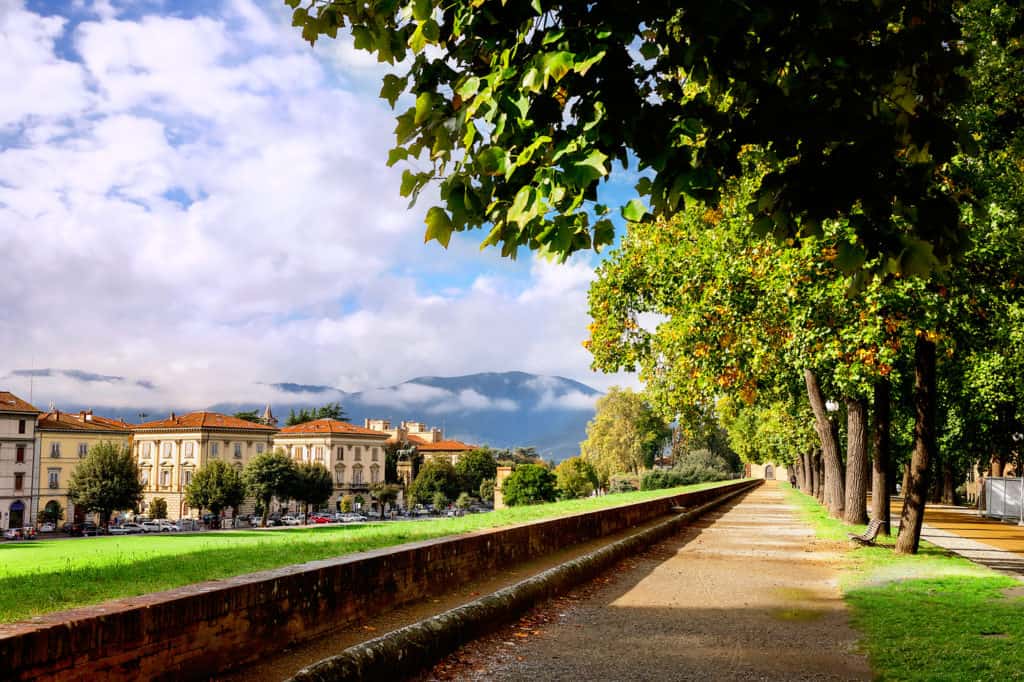
Walking or Biking the City Walls
As you approach the historic core of Lucca, you’ll see that the town is surrounded by its old city walls, one of the most defining and endearing aspects of a visit here. A circumnavigation of the walls gives the visitor a different perspective ion Lucca’s buildings and churches, and the ability to look out beyond the old town core to the newer parts of Lucca and beyond to the mountains. The walls are tall and stout, about 40 feet high and almost 100 feet thick at the base. The green areas below the walls are where the moat provided an additional barrier against invading armies.
What is remarkable is that the walls still exist at all. Built for defensive purposes, these current walls from the 16th and 17th centuries replaced the earliest Roman and medieval walls, and then were left intact instead of being dismantled once thee need for fortified protection was past. In the early 1800s, the Duchess of Lucca turned to architect Lorenzo Nottolini to convert the walls into a public park and pedestrian promenade.
There are 11 bastions, area where the ramparts protrude out to give troops an excellent vantage point on any invading force, plus six gates that could be closed in the event of attack. The walls are a great recreational area, with grassy lawns, playgrounds for kids and picnic tables in certain areas.
You’ll see plenty of runners and walkers along the 2.5-mile loop of the walls around the city center, but to my mind the most enjoyable way to experience the walls is by bike. There are several bike rental companies located near the city gates, but the one I used was Poli, which is just across from the entry ramp to the walls at the Porta Santa Maria on the northern part of Lucca. You can rent a bike for 4 euro for an hour, which gives you plenty of time to cycle around the full length, including stops for pictures.
It’s easy to just amble along the walls or rent a bike for great city views on your own, but if you’d like to mix in an interesting tour, you can choose from a 2-hour walking tour for $11.37 per person, or hop on two wheels for a fun 3-hour biking tour of the walls and city highlights for $96.63 per person.
Admire Lucca’s Great Churches
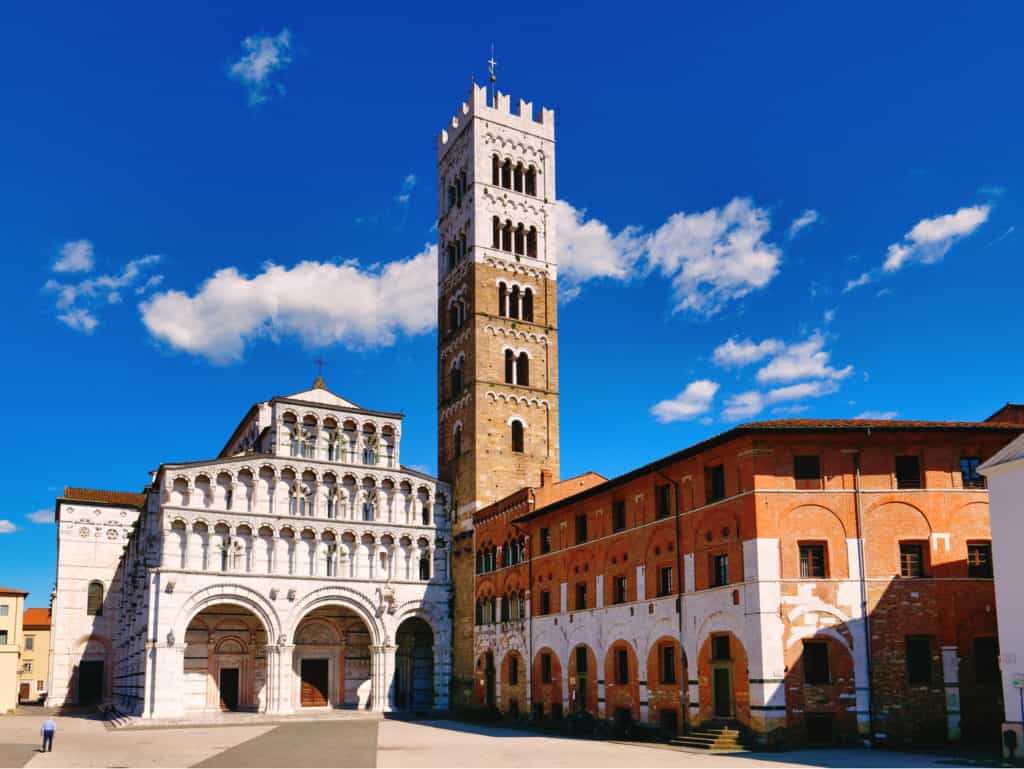
San Martino Cathedral
Lucca is called the town of one hundred churches, and it can be difficult to select just a few that are the best, but San Martino Cathedral is one of the top things to see on your visit. Entering Piazza San Martino for the first time, you’ll be taken by the great Gothic architecture of the cathedral built in white marble, and the bell tower alongside constructed out of brick at the base and marble at the top. The bell tower rises 226 feet high and can be climbed for a scenic panorama over the town and beyond.
Although the church was first consecrated in 1070, work on the façade by Guido Bigarelli of Como did not begin until 1204. During the 14th century it was decided to undertake a reconstruction of the entire church, which was not finished until 1476. Construction on these massive religious edifices took centuries to complete.
On the façade you’ll spot a sculpture of St. Martin, for whom the cathedral is named. St. Martin was a former Roman soldier who famously gave half of his cloak to a needy beggar. The statue of this scene on front of the church is a copy, and the original is just inside. The carvings by Nicola Pisano above every arch and door bring great variety, describing scenes from the life of St. Martin, visual depictions of the months of the year, and there’s an interesting carving of a small labyrinth on the right side of the portico.
The three large arches facing the piazza have varying widths with the right-most arch smaller to squeeze in the bell tower construction. They open to a recessed portico clad in marble; above it rises three tiers of spectacular loggias set on little columns, each one different from any other.
The two most famous works of art in the cathedral are the Volto Santo or Holy Face, one of the most famous Christian relics. This crucifix with the body of Christ is said to have been carved by Nicodemus, who helped take Christ’s body off the cross. The visage on the crucifix is supposed to be a realistic depiction of the true face of Jesus. The wooden crucifix is housed in an octagonal chapel of red and white marble in the left nave of San Martino, constructed by Matteo Civitali.
The second wonderful piece of art inside is the funeral monument of Ilaria del Carreto by Jacopo della Quercia, made in 1408. Ilaria was the second wife of Luccan lord Paolo Guinigi but she died in childbirth at age 26 just two years after her marriage. This gleaming white marble tomb is a touching tribute to the young woman, resting in her eternal pose, with a small dog at her feet representing her fidelity.
Other artworks to look for in the cathedral or attached museum include a Madonna and Child with Saints by Domenico Ghirlandaio and a Last Supper by Jacopo Tintoretto.
There is a 9 euro combined admission fee for the cathedral, museum, belltower, and Baptistery.
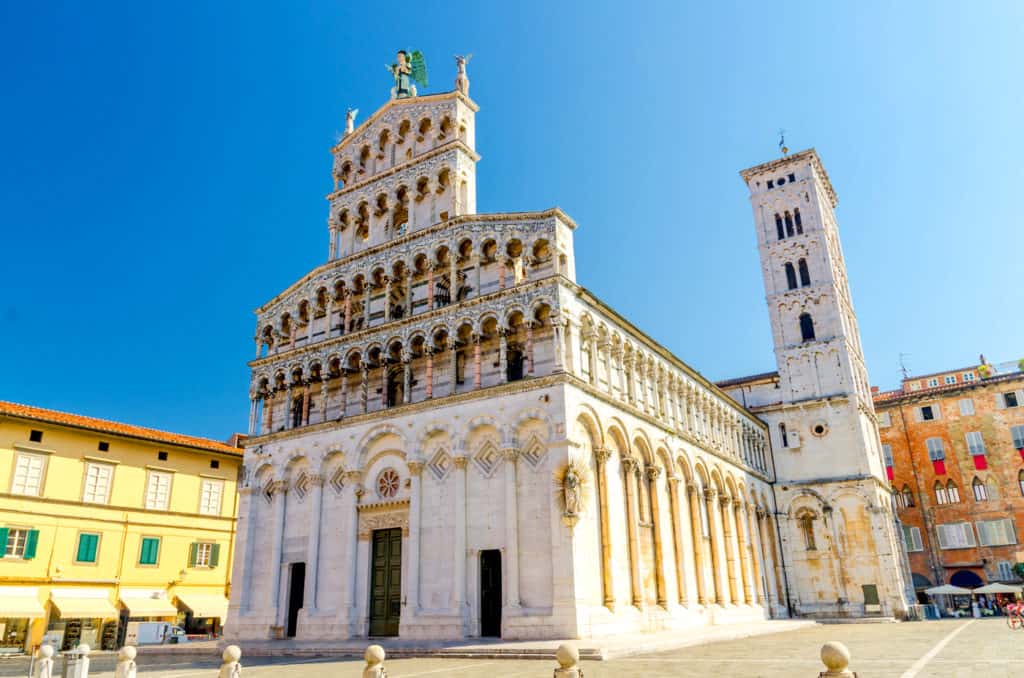
San Michele in Foro
Entering the Piazza San Michele, you’ll be dazzled by the beautiful white marbled San Michele in Foro church that fills the square. If you’re approached from the side and the belltower, make your way around to the front, which has a spectacular façade topped by a bronze statue of a metal winged Archangel Michael slaying the dragon. It seems that after the front façade of the church was built, there was no money left to raise the nave, so the upper sections are very thin and have nothing but air behind them!
The name of the church refers to the location where it was built, on the site of the old Roman forum. The pillars and columns are full of sculpted details, so much so that you may want to have a pair of binoculars to pick out all that’s going on. Moving from the entry doors up, you’ll spot two lions flanking a rose window. Then four tiers of small columns follow, all with carvings of heads, animals, and flowers, and above each row there’s a frieze upon which animals run and jump.
The inside of the church is not as spectacular as the façade but look for the impressive 1479 painting by Filippino Lippi of Saints Helen, Jerome, Sebastian and Roch and the Madonna carved by Matteo Civitali in thanks for the town’s deliverance from plague in 1476.
Admission to the church is free.
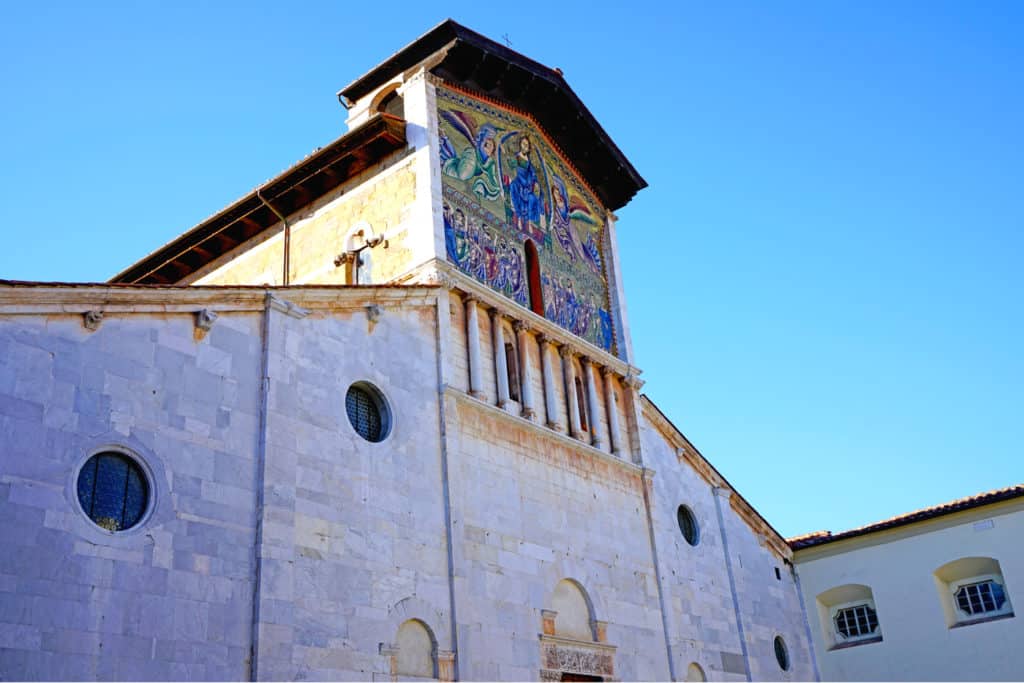
San Frediano
You’ll likely be approaching San Frediano from off the main route through the city of Via Fillungo, and as you get your first glimpse, you’ll be stunned by the beauty of the colorful mosaics with gold-leaf tiles adorning the topmost section of the façade.
The two-story-tall 13th-century mosaic by Berlinghiero Berlinghieri depicts Christ’s ascent to heaven. The church faces east, so the mosaics are particularly spectacular when lit by the morning sun.
The original church was built by Irish Bishop Frediano in the 6th century, and rebuilt between 1112 and 1147, and then renamed after the now sanctified San Frediano.
One of the chief artistic highlights rests just inside the church’s entrance to the right, a Romanesque baptismal font from the 12th century. The stories of Moses grace the lower basin, carved by a Lombard sculptor, while the upper tempietto shows the apostles and the months of the year on the lid.
Behind the font high up on the wall is a beautiful, glazed terra cotta lunette of the Annunciation attributed to Andrea della Robbia. On the left side of the church, the works in two chapels stand out. In the Chapel of the Trenta family, there is a reredos and tombstones by Jacopo della Quercia. In the Chapel of Sant’Agostino are Lucca’s most famed frescoes, a series by the Bolognese painter Amico Aspertini, the best of which show the Miracle of San Frediano, and the Arrival of the Voto Santo in Lucca.
Admission to the church costs 3€.
Historic Towers with Great Views
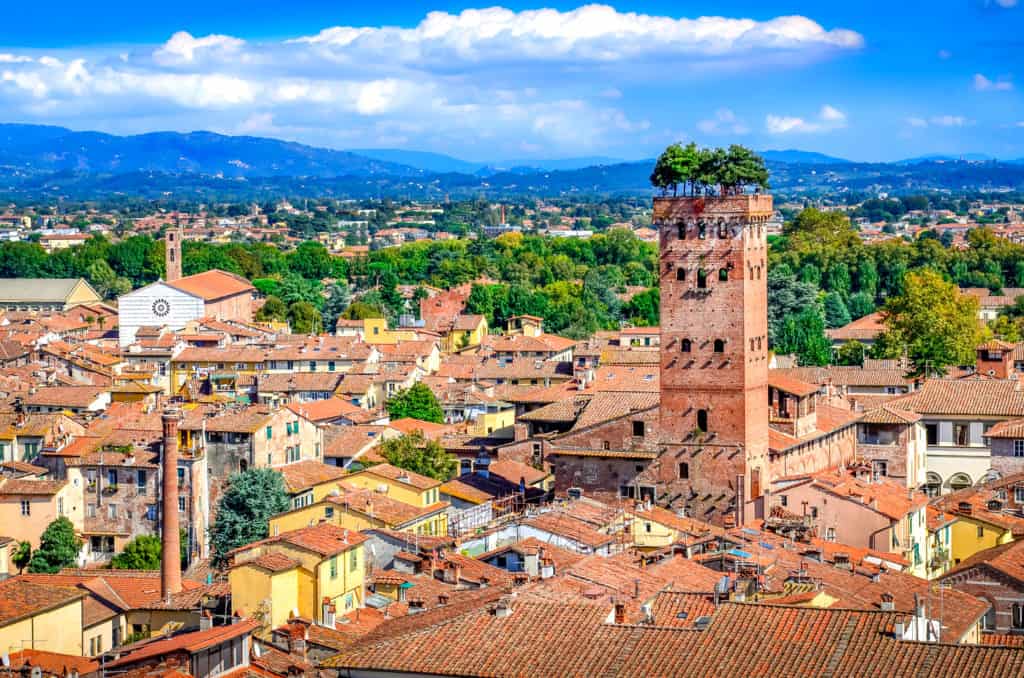
Torre Guinigi
One of the most striking elements of Lucca’s skyline are several medieval towers that have survived the years, and now offer great perspectives overlooking the town from their viewing platforms. The most unique such building is the Guinigi Tower, due to the holm oak trees that are in the rooftop garden. It’s an odd sight to spy the old red brick tower on your rambles about town and see the trees sprouting from the top terrace!
At nearly 150 feet tall, the Tower was built in the 14th century to show off the power and wealth of the town’s ruling family. Though you’ll have to navigate 230 steps to get to the top, the 360-degree panorama, with the unique rooftop oak tree garden, is memorable. The tree-topped tower remains one of the symbols of the city.
Admission is 5 euro for adults or 9-euro combination ticket with the Clocktower (Torre delle Ore) and the Botanical Garden.
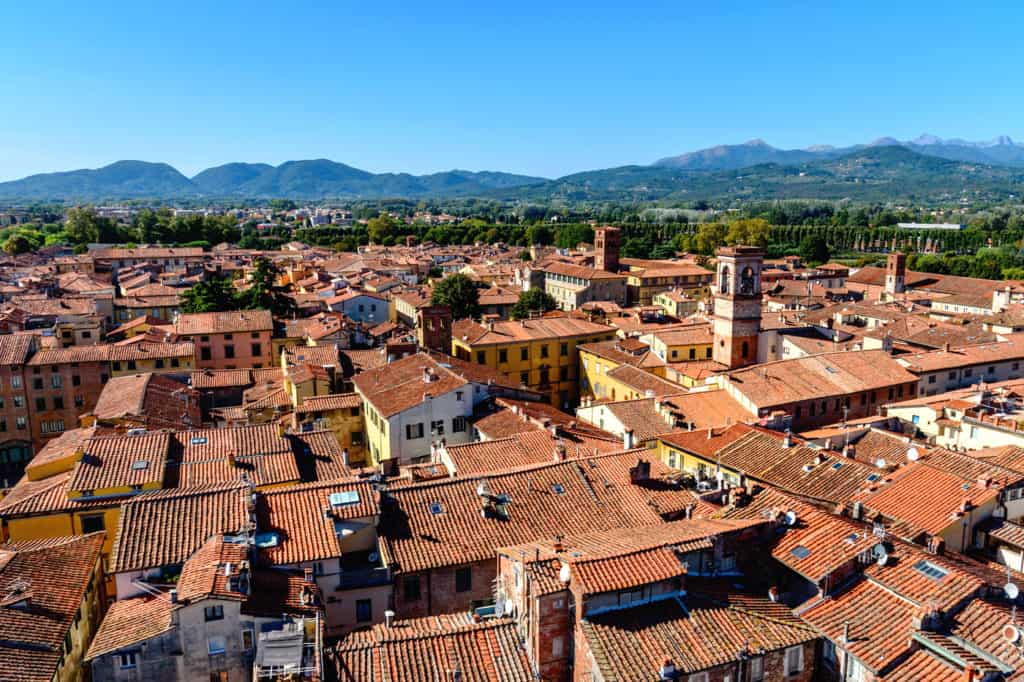
Lucca’s Clock Tower (Torre delle Ore)
Another tower to climb to take in the city landscape is the 13th century Torre delle Ore clocktower. This is the highest spot in Lucca, with the tower almost 165 feet high. The first mechanical clock was installed in 1390, while the current version was put in place in 1754. The clock has one large bell that rings the hours and four smaller bells that sound the quarter and half hours.
Get ready for some exercise, as the climb to the top is 207 steps up a wooden staircase. Take note of the time, as the tolling of the bells is deafening if you happen to be at or near the top when they start ringing! The steep climb is rewarded by excellent panoramic views over the town. Perhaps the best part of choosing to climb the clock tower is that you get to see the Torre Guinigi with its tree garden in your view, as opposed to if you chose the Guinigi Tower instead of the clocktower to climb.
Admission is 5 euro for the Tower alone, or a combination ticket covering the nearby Guinigi Tower or the Botanical Garden costs €9 for all three sights).
Visit Lucca’s Best Museums, Like Villa Guinigi National Museum
Housed in the 15th century former summer home of the city’s former ruler, Paolo Guinigi, the Villa Guinigi National Museum has a collection of archeological pieces and sculpture from Etruscan and Roman times as well as Medieval and Renaissance art, sculpture, and paintings.
Built between 1413 and 1430, the Villa Guinigi has a porticoed façade and a Tuscan late Gothic style. Guinigi ruled Lucca from 1400-1430, and his former home of is one two national museums in the town, the other being the Villa Mansi.
There are sculptures by Donatello and Matteo Civitali, and paintings by Tuscan artists such as Giorgio Vasari and Fra Bartolommeo.
Museum admission costs 4 euro.
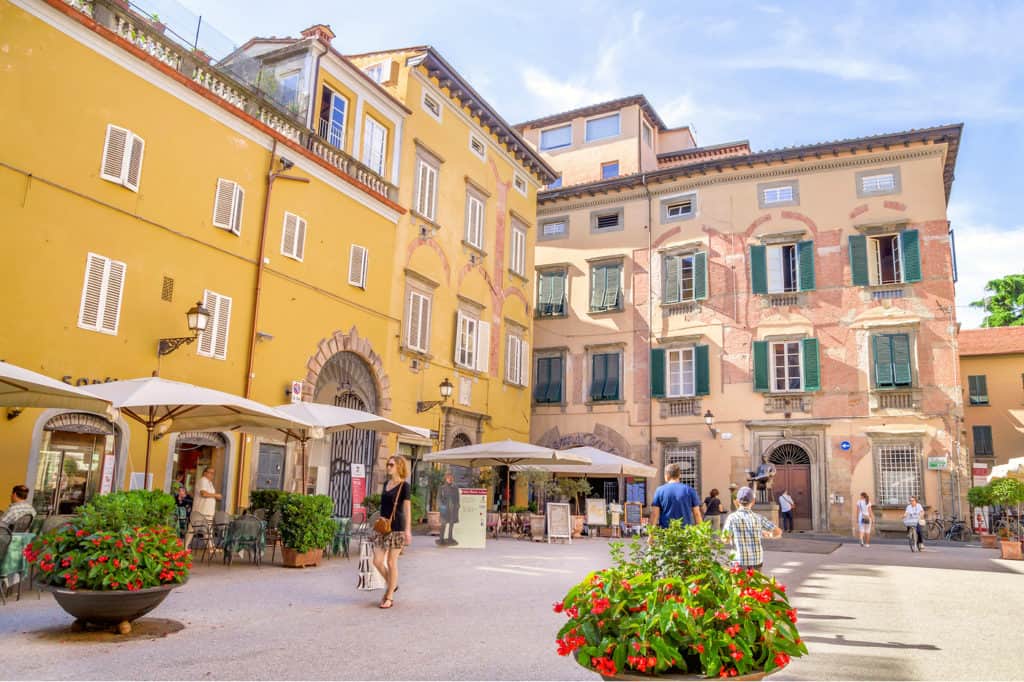
Giacomo Puccini Museum
One of Lucca’s most famous former residents is the famed Italian opera composer Giacomo Puccini, whose birthplace is now the Puccini Museum. The author of famous operas such as La Bohème and Madame Butterfly was born here in this house in 1858 and the museum celebrates his life and accomplishments. Adjacent to the museum in Piazza Cittadella is a bronze statue of him in a suit with vest and bow tie sitting in an armchair, one leg crossed over the other.
The rooms of the house have been refurnished as they were, and the piano Puccini used to compose music on is here, along with paintings, copies of scores, opera posters, letters, photographs, and personal mementoes of his life.
The admission fee is 9 euro. Combined Tickets for the two National Museums € 6,50.
Get to know more about this giant of Italian opera on this two-hour musical walking tour that includes a visit to the Puccini Museum for $17/18 per person. There are also frequent evening performances featuring Puccini’s music, such as this one-hour concert costing $28.64 per person.
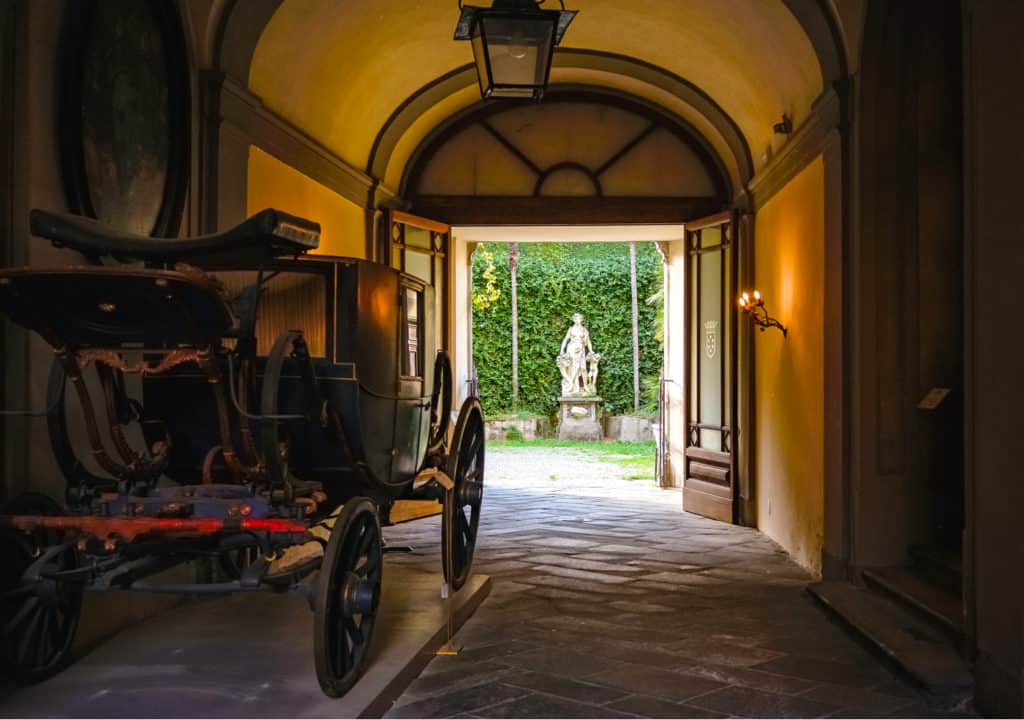
Palazzo Mansi National Museum
The Palazzo Mansi National Museum gives you a glimpse inside a beautiful palace which now houses a collection of paintings, frescoes, tapestries, and other precious art. The setting is a beautiful 16th century mansion that was once owned by a wealthy merchant and was purchased by the state in 1965.
It now houses a fine arts gallery with paintings from the Medici and Grand Ducal collections by the likes of Tintoretto, Vasari, Pontormo and Bronzino. The most eye-catching parts of the palace apartments are the first-floor rooms, including the frescoed Music Hall with a small orchestral stage, the chapel, and the Hall of Mirrors. Original furniture and Flemish tapestries grace the rooms. On the second floor is artwork of 19th and 20th century artists from Lucca.
Museum entry costs € 4.00. Combined tickets for the two National Museums, including Villa Guinigi) costs € 6,50.
Stroll Historic Piazzas and Medieval Streets
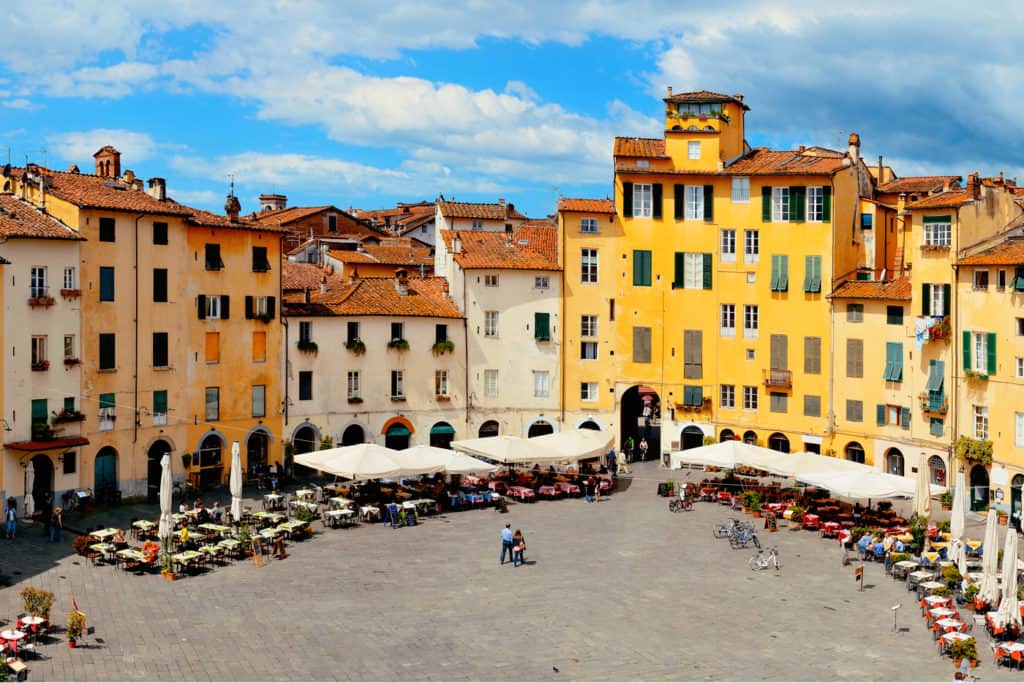
Piazza dell’Anfiteatro
This isn’t your typical Italian piazza. Only four small tunnel-like passages lead into the Piazza dell’Anfiteatro, which opens up into a circular plaza that follows the contours of the old Roman amphitheater that was originally built here in the 1st century A.D.
Inside is like a stage set with the large oval space filled with outdoor tables from the restaurants and cafes, a great place to sit out in the sun and have an aperitivo or meal. This is one of the centerpieces of the city, constructed innovatively between 1830 and 1839 by the architect Lorenzo Nottolini.
Over the centuries, subsequent conflicts led to the amphitheater being fortified and the open outer arches closed. Later, houses were built up within the structure and its stones used for other construction in the town. Nottolini was able to reconstruct the original circular space of the arena while constructing or demolishing buildings to allow the new urban space to curve around and follow the track of the original building. The inner area became the piazza itself.
There is a very active social scene here into the night for the locals’ passegiatta or evening stroll. Events and concerts take place here during the summer months. Be sure to also walk around the Via dell’Anfiteatro, which traces the curve around the exterior walls on the piazza’s buildings, with additional shops and restaurants to visit.
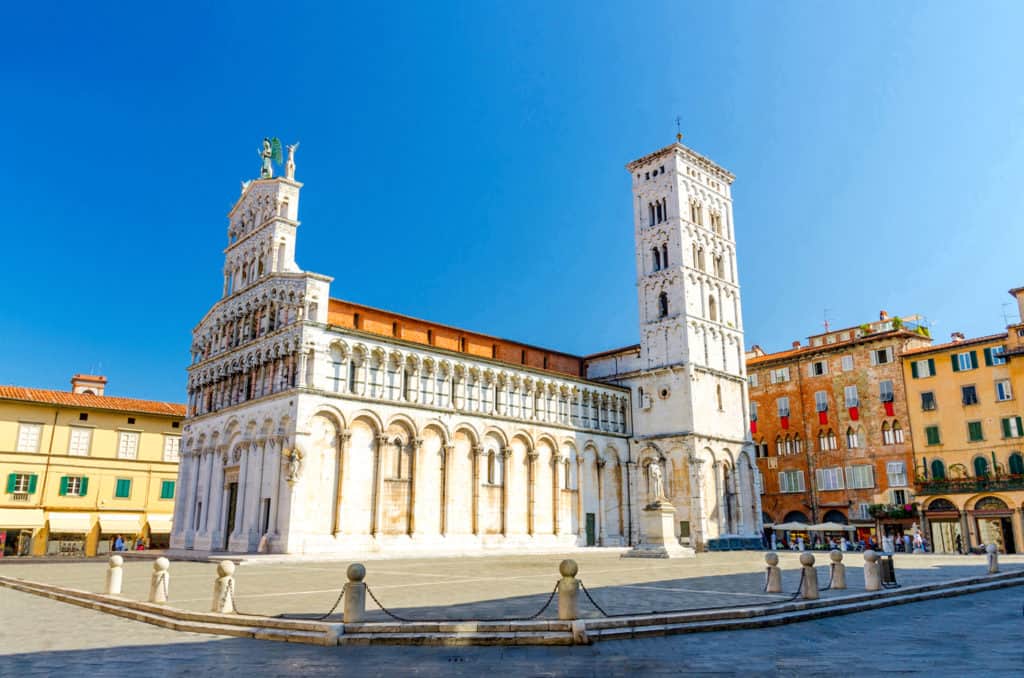
Piazza San Michele
The Piazza San Michele is a grand stage occupied by the San Michele in Foro Church and ringed by architecturally fascinating buildings housing former commercial businesses.
The “in Foro” refers to this being the location where the Roman Forum once stood. It is still one of the main gathering places of the city, and destination for evening strolls, with the San Michel church taking prime position.
Other impressive structures ring the Square, including palazzos that formerly held banks and the Palazzo Pretorio with its clock, and a gracious loggia with a statue of architect and sculptor Matteo Civitali, who designed the building and sculpted some of the most noteworthy artwork appearing within Lucca’s churches.
Pull up a chair at one of the restaurants offering outdoor seating and take in the passing scene.
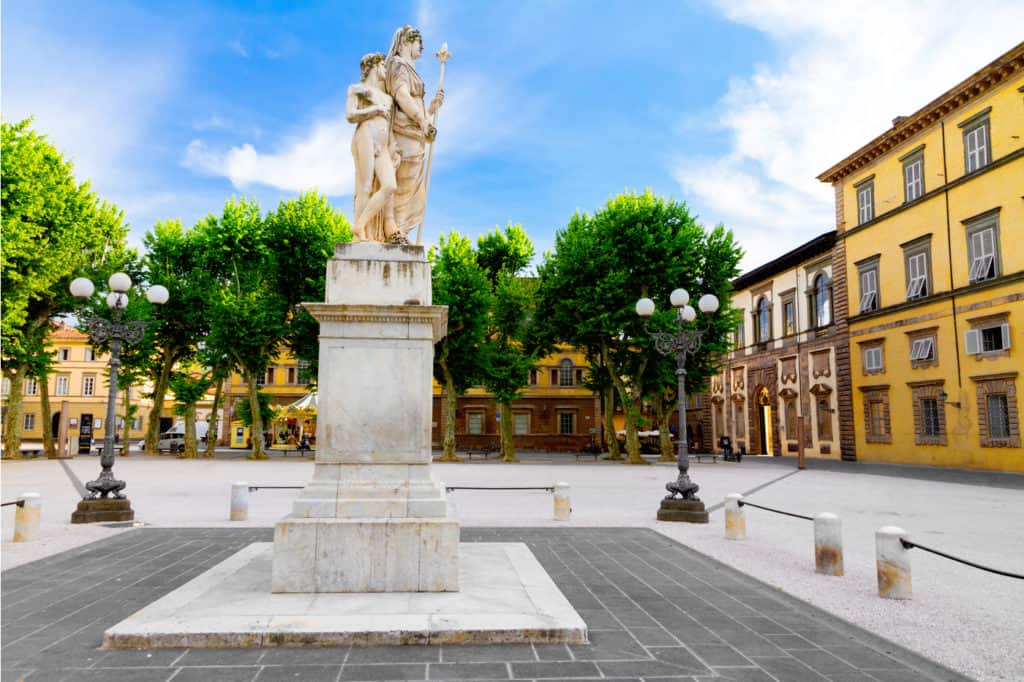
Piazza Napoleone
Piazza Napoleone is commonly known as Piazza Grande, but was named after the work that Napoleon’s sister, Elisa Bonaparte Baciocchi, who led the Principality of Lucca between 1805 and 1815, did in restructuring the square.
Under the subsequent rule of the Duchess of Parma, architect Lorenzo Nottolini was hired to renovate the Ducal palace and sculptor Lorenzo Bartolini commissioned to erect a statue in the middle of the square in her honor.
This large square is another gathering point in the city center, with the impressive Renaissance Ducal place, built starting in 1578, stretching along the entire west side, and housing the province’s administrative offices as well as the Emigration and Risorgimento museums.
The square had its ice rink in place the last time I visited, part of the winter festivities that take place here, along with a merry-go-round. In summer this is where many of the concerts associated with the Lucca Summer Festival take place.
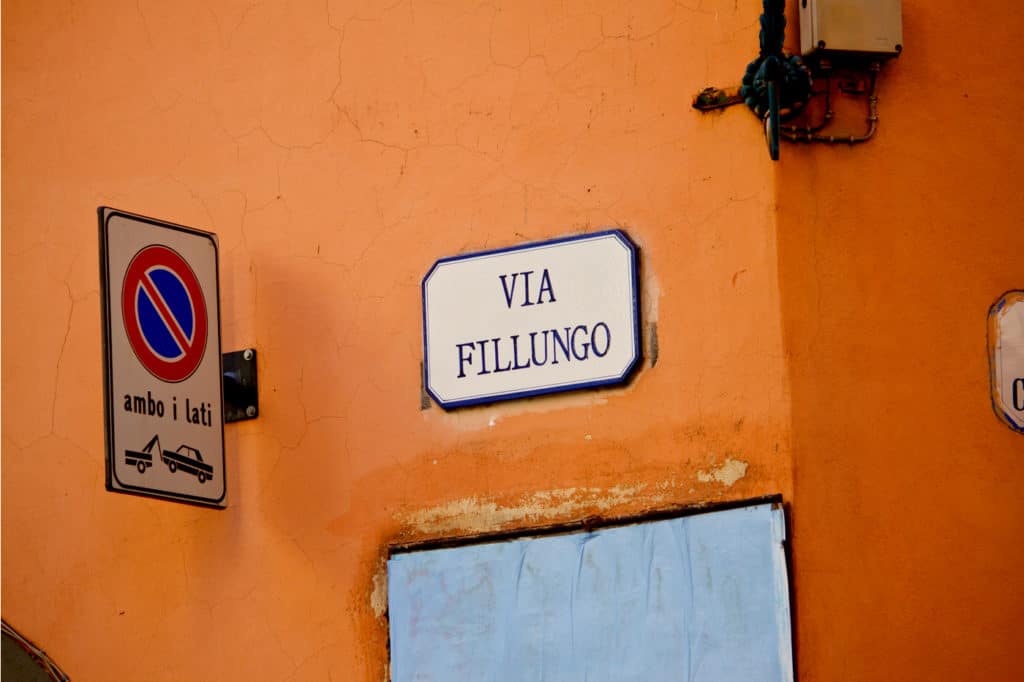
Shopping in the Via Fillungo
It’s impossible not to spend time along Via Fillungo, Lucca’s main street, that cuts through the core of the historic center. This main shopping street winds through much of the town’s center, past intriguing buildings, inviting piazzas, clothing stores and boutiques with art nouveau signs and pastry shops selling tempting treats.
Relax in Beautiful Gardens
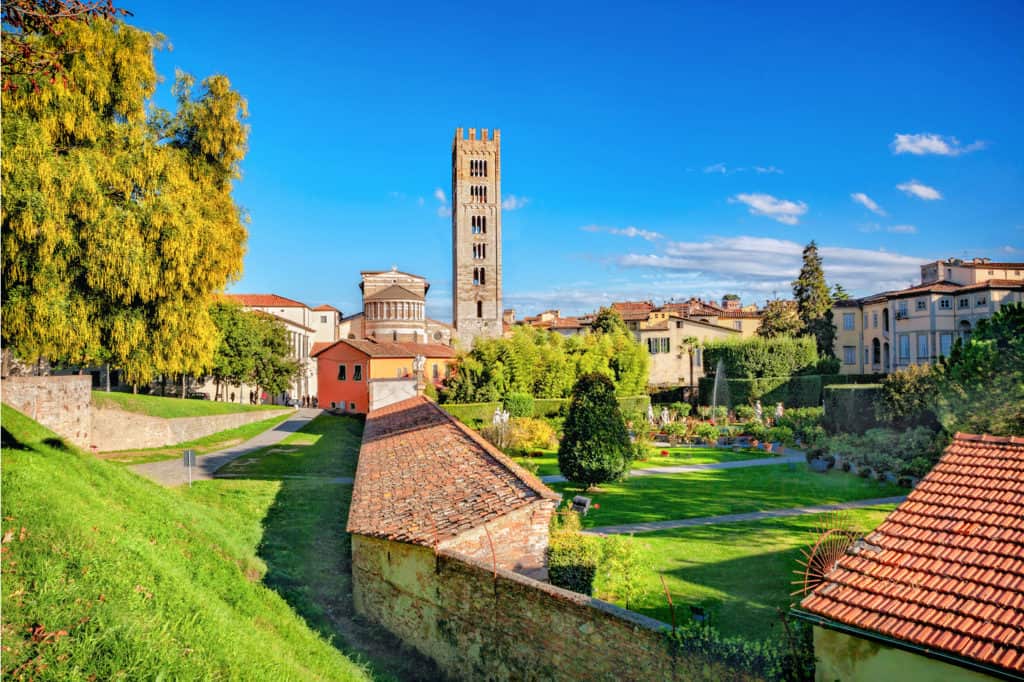
Palazzo Pfanner
One of Lucca’s palaces that can be visited is the Palazzo Pfanner. Located at the north end of town near the Porta Santa Maria, the Palazzo is best known for its beautiful gardens, which stretch out behind the palace and can be glimpsed from the city walls. The palace was built in the 17th century, and purchased in the 19th century by the Pfanners, a family of Austrian/German brewers.
An ornate staircase leads down from the Palace’s interior into the lush garden with a row of statuary, as well as fountains, an ornamental pond, lemon house and formal plantings. The 1996 Hollywood movie “Portrait of a Lady” was filmed here.
The inside of the palace may also be visited and gives an idea of early 18th century palace life from its frescoed main reception room to the dining room table set for lunch, and copper pots hanging in the kitchen.
A combined visit to the palace and gardens is 6.50 euro. Separate admission to either the palace or garden is 4.50 euro.
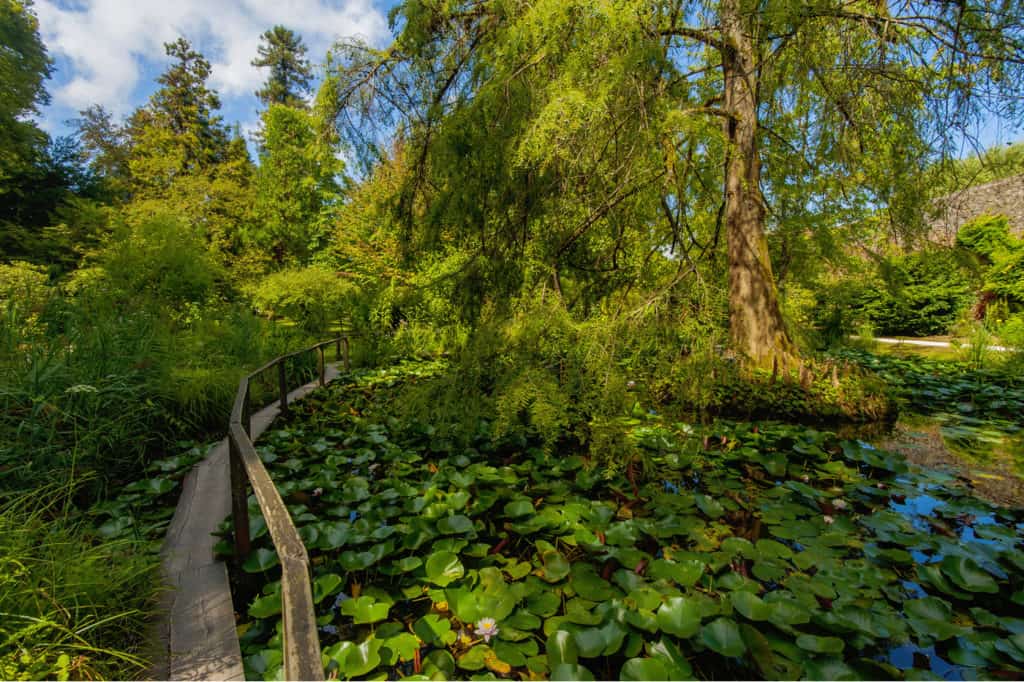
Lucca’s Botanical Gardens
Sprawling across nearly five acres and abutting the city walls and two of the bastions, Lucca’s Botanical Gardens are worth a stroll away from the center, in the shade of its impressive Cedar of Lebanon tree, which is over 70 feet tall and has become the Garden’s symbol.
Founded in 1820 by the Duchess of Parma, the extensive gardens feature greenhouses and an arboretum with many species of trees, plants, and flowers from all over the world, as well as a pond which even contains a bald cypress, originally from swamps in Florida.
Garden admission costs 5 euros.
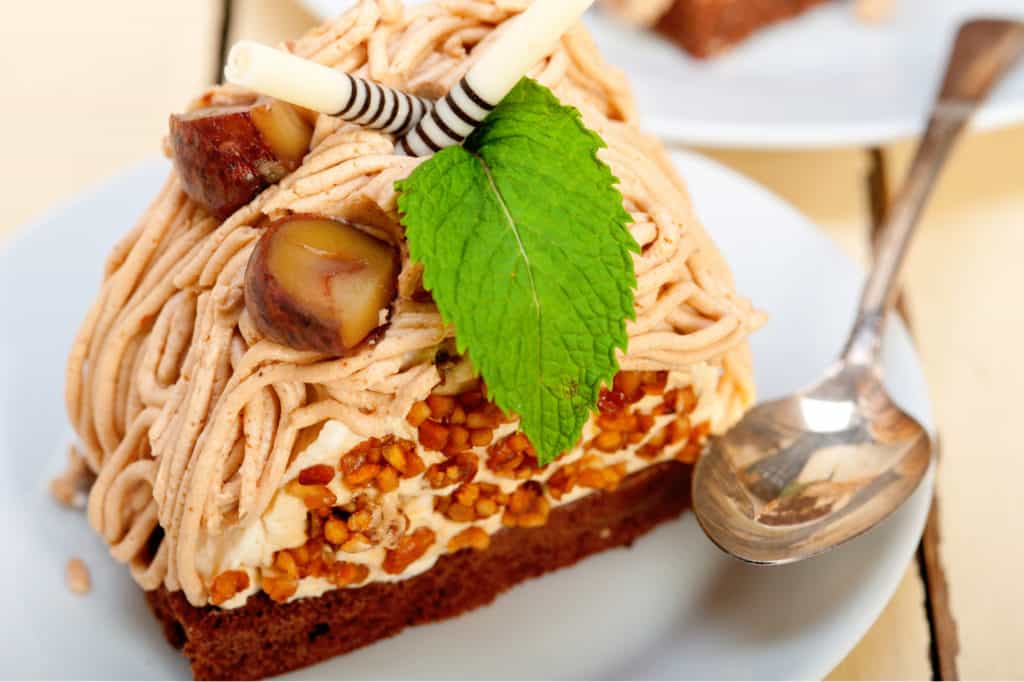
Savor the Local Food
As with most Tuscan cities, you’ll find local specialties that are worth seeking out at local restaurants during your stay. A couple savory examples are zuppa di farro, soup made with the grain called farro along with vegetables and beans, and tordelli, an egg pasta with minced meat, mortadella, grated cheese, and herbs. Then there is rovelline di Lucca, literally ruins from Lucca that consists of breaded and fried meat in a tomato and caper sauce, and garmugia is a spring soup with beans and vegetables such as asparagus, peas and artichokes plus minced beef or veal.
Dessert specialties included the chestnut flour-based cake called castagnaccio with raisins and pine nuts, and the famed bucellato, which is an aniseed-flavored cake with raisins, which can be shaped like a small loaf of bread. I sampled bucellato at the venerable Pasticceria Taddeuci, in business since 1881, at a handful of outdoor tables across from the shop entrance facing the bustling and historic Piazza San Michele.
For some more in-depth exposure to Luccan food and cooking, try this 5-hour market tour and home cooking class priced at $216.49 per person.
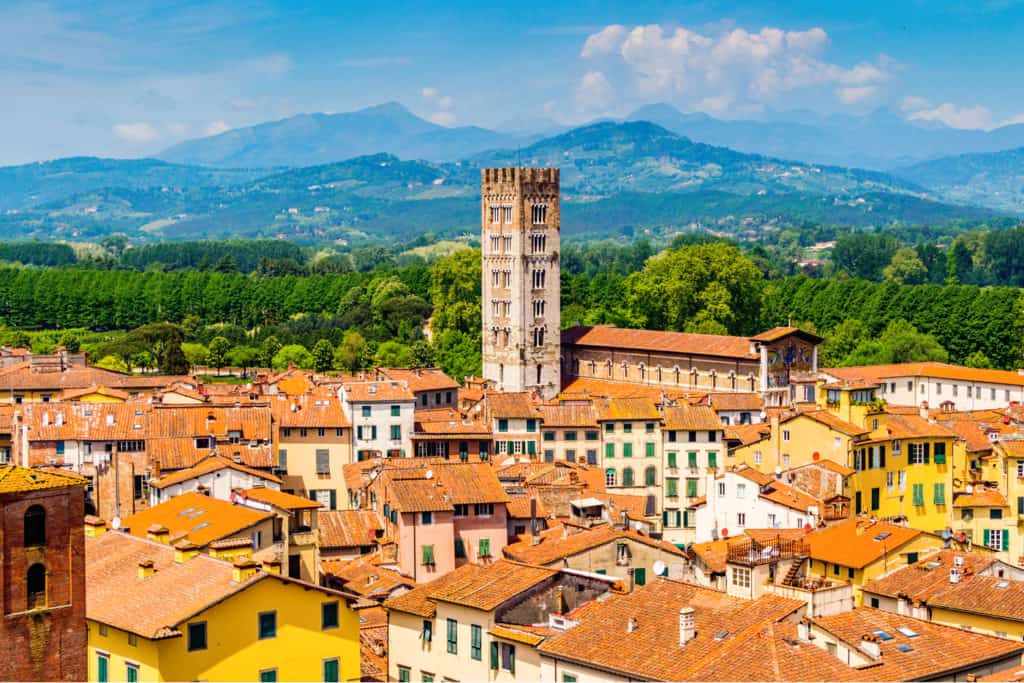
Lucca allows visitors to take a more unhurried approach, with not as overwhelming a list of attractions as Florence, nor superstar sights like the Leaning Tower complex in nearby Pisa. But there is still much to enjoy, and the encircling city walls create a unique setting with a historic core that is a joy to walk through.
Visiting the trio of star churches, ascending the city’s medieval towers for sweeping views, getting more familiar with Puccini, admiring the historic piazzas where Roman structures once stood and rambling along the atmospheric Via Fillungo will fill a day or more of an enjoyable stay. This is one of Tuscany’s jewels and should not be missed.
Related Articles on Italy
🇮🇹 Top Things to Do in Milan
🏛 23 Things to Do in Rome, Italy
💰 The Cost of Travel in Rome: A 2023 Budget Breakdown
🚤 53 Best Things to Do in Venice
🛬 How to Make the Most of a Layover in Venice
🍕 The Absolute Best Things to Do in Florence, Italy
🍝 23 Magical Things to Do in Siena, Italy (2023)
🍹 21 Incredible Things to Do in Bologna, Italy
🎉 Liberazione: What to Expect From Italy’s Liberation Day

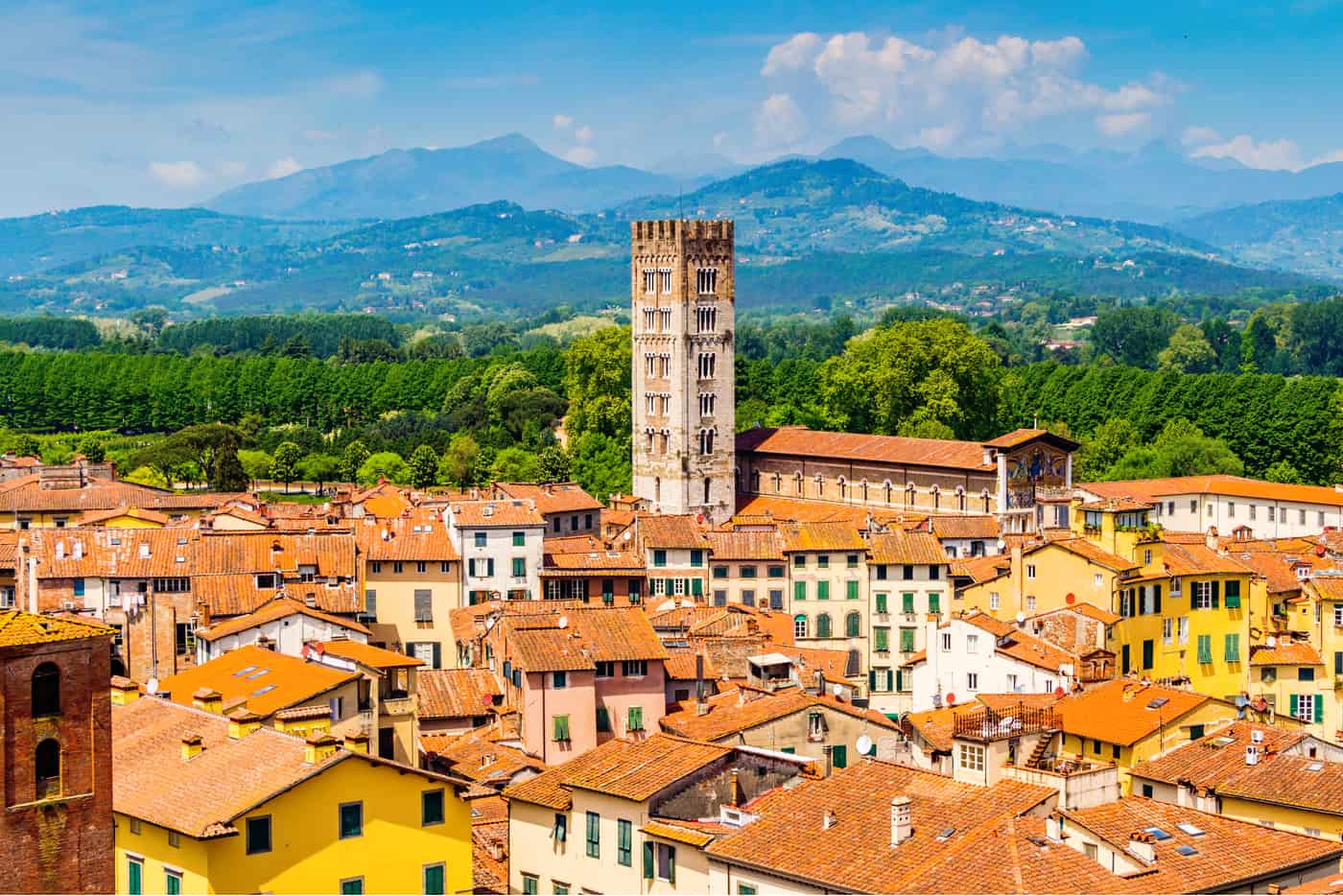


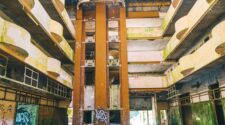
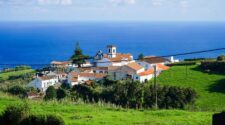
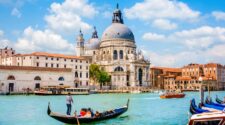

No Comment